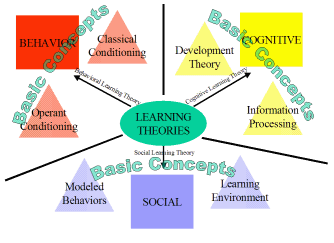 I have learned a great deal over the course of the last 8 weeks. Throughout the EDUC 6115 Course I feel that I was enlightened. The vast majority of what I learned was new information to me. As an online instructor I am familiar with some of the online learning to a certain extent, however I did not realize how much I did not know about learning theories. One of the most striking things that I have found as I gained a better understanding of how individuals learn is that there are some many influential factors that affect the learning process. Some of these factors include mental factors (attitude), personal factors (emotional and social), environmental factors (physical conditions), and learning factors (Mondal, 2015).
I have learned a great deal over the course of the last 8 weeks. Throughout the EDUC 6115 Course I feel that I was enlightened. The vast majority of what I learned was new information to me. As an online instructor I am familiar with some of the online learning to a certain extent, however I did not realize how much I did not know about learning theories. One of the most striking things that I have found as I gained a better understanding of how individuals learn is that there are some many influential factors that affect the learning process. Some of these factors include mental factors (attitude), personal factors (emotional and social), environmental factors (physical conditions), and learning factors (Mondal, 2015).
My Personal Learning
As I further reflect on this course, I definitely feel that it deepened my understanding of my personal learning process. Interestingly enough, I had never really given any in-depth thought to the way that I learn. I have given much thought to the way that others learn, but not myself. When I think about the definition of ‘learning’, what comes to mind is the transference of knowledge. There are conventional and unconventional methods of learning and again I have never really given this much thought when it comes to my personal learning. The method that seems to work best for me is linguistic or verbal learning. The use of words in both writing and verbally helps me to learn most productively. I use many electronic resources for learning, many of which are mobile devices. Several months ago, I learned that the use of mobile devices such as phones and tablets in learning is referred to as mobile learning (m-learning) and the delivery of electronic materials on these devices is electronic learning (e-learning). During this current course, I have learn more about the learning theory that best best aligned with the way that I learn and that is Connectivism. Interestingly enough, of the theories that we discussed in the course, it was the one on that I have not heard of.
Learning Theories, Learning Styles, Educational Technology, and Motivation
 The Learning Theory Matrix assignment really helped me to understand the connection between learning theories, learning styles, educational technology, and motivation. Prior to understanding the connections between these elements, I had to first learn to decifer what they were and the differences between them. Learning theories provide a framework that can be used to describe how information is absorbed, processed, and retained during the learning process. An individual’s learning style is the manner in which he or she understands and comprehends information. Educational technology allows us to better serve the diverse learning styles among individuals. Motivation is the willingness to do something. In terms of enhancing learning, motivation is perhaps one of the most important factors that educators need to take into consideration.
The Learning Theory Matrix assignment really helped me to understand the connection between learning theories, learning styles, educational technology, and motivation. Prior to understanding the connections between these elements, I had to first learn to decifer what they were and the differences between them. Learning theories provide a framework that can be used to describe how information is absorbed, processed, and retained during the learning process. An individual’s learning style is the manner in which he or she understands and comprehends information. Educational technology allows us to better serve the diverse learning styles among individuals. Motivation is the willingness to do something. In terms of enhancing learning, motivation is perhaps one of the most important factors that educators need to take into consideration.
The Field of Instructional Design
There were many useful pieces of information within this course that will help me as I further my career in the field of instructional design. I have learned that one of the key element to connecting the instructional designer, the learner (and their learning style), and education technology is motivation. Also useful, is an understanding of information processing. From an instructional design perspective, when thinking about teaching adult learners, it is important to know what they already know so that they can relate the new information to their existing knowledge. In Week 6’s learning resource video, Dr. Ormrod explained the significance of accounting for the differences in the way individuals learn and taking them into consideration in any instructionally designed learning environment. The goal of instructional design is to make learning more efficient and effective as well as resolve instructional problems. There is no single perfect approach to instructional design or one size fit all learning theory. Although some are more suitable for certain instructional tasks than others, they all have major benefits. A good design model is one that offers flexibility (customizable), leads to instruction that meets the needs of the learner, cost effective, and includes an evaluation component.